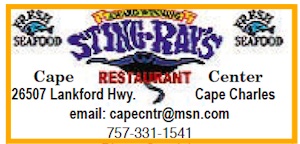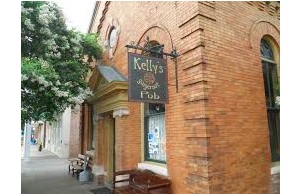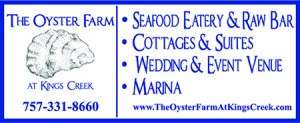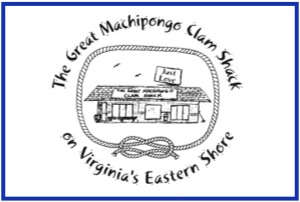County Supervisors Repeal Mid-Year Property Tax, Approve EMS Land Purchase
By WAYNE CREED
Cape Charles Wave
May 4, 2015
When the Northampton Board of Supervisors met April 26, at the top of the agenda was repealing the semi-annual property tax. With immediate consensus, the motion to remove was approved unanimously.
When the topic turned to the fate of the former middle school in Machipongo, and whether to renovate part of it to house Northampton Emergency Medical Service, battle lines were quickly drawn, with historical and cultural preservationists Oliver Bennett and Larry Trala on one side and fiscal pragmatists Granville Hogg and Larry Lemond on the other. Rick Hubbard was caught squarely in the middle.
Engineers from DJG were on hand to answer questions from the Board. DJG had provided the initial estimate for the county last year; that estimate, for a full restoration/renovation, was over $5 million. Supervisor Bennett asked the architect, Donald Booth, what the figure would be if they just focused on a phased approach, possibly looking at just the auditorium and cafeteria as a starting point for the new home of EMS. Booth agreed that breaking the project into phases, using efficient zoned heating and cooling, would be less painful, and in the ball park of $1.4 million to renovate a new space. More efficient, zoned HVAC would also take a big bite out of yearly operating costs by focusing heating and cooling when and where needed.
“We look at costs,” said Bennett. “But the auditorium and cafeteria are not in as bad a shape as many people perceive it to be. We already own the property. It has historic value to many. We’re always talking about this or that that has historic value. Those who are against it, well, some don’t have a relationship with that school that goes back 50 years, and may not understand the historic value. We need to look at the whole picture — we can’t just take away, but we need to leave a piece of our history. I’m not talking about spending too much, but reasonable spending.”
Lemond countered, “I’m not in favor of putting one penny into that old building — we could tear down all of it, except maybe the gymnasium.” [Read more…]
ANNUAL MEETING: CBES, Shorekeeper Pledge to ‘Protect and Defend What We Love’

Spencer Murray received the Suzanne Wescoat award in recognition of outstanding achievements in stewardship of the shore. CBES Executive Director Donna Bozza (right) , recalled Wescoat’s words that “economic success and environmental stewardship are connected.”
By WAYNE CREED
Cape Charles Wave
May 4, 2015
The Eastern Shore of Virginia is considered one of the last pristine coastal wilderness zones left on the east coast. For many, the last few years have seemed like a battle to preserve the quality and well-being of these delicate coastal waters. Maintaining a constant drumbeat, and providing solid boots on the ground in this effort to preserve and enhance the overall quality of life on the shore have been the sister organizations Citizens for a Better Eastern Shore and Eastern ShoreKeeper. Last Tuesday (April 28) these groups met at Little Italy in Nassasaddox for their annual meeting.
“Our waters now have a voice. We are an advocate for our water quality,” said Shorekeeper Executive Director Jay Ford. “Clean water is an economic driver, has economic importance — we have met with legislators, and have brought political scrutiny.”
Ford noted that through grass roots efforts of CBES and Shorekeeper members, they have been able to influence some parts of Northampton County’s proposed zoning changes, such as maintaining Chesapeake Bay Act protections on the seaside and pushing back on shoreline widths. “Also, there will be no chicken-growing in Northampton,” said Ford. “Our waters are too fragile; they cannot handle the influx of that many nutrients. Still, even with our successes, the work is not done,” he stressed. [Read more…]
In Defense of Meat and Other Animal Products
By KAREN GAY
Wave Columnist
May 4, 2015
This contin ues my previous article about the Weston A. Price Foundation’s dietary principles. I’ll discuss the Foundation’s belief that health is best found in a diet of unprocessed, traditional foods containing some sort of animal product, be it fish, shellfish, fowl, sea mammals, eggs, milk and milk products, or even reptiles or insects. There has been some discussion in the Wave regarding the virtues of a vegetarian diet, and I’d like to provide a gentle rebuttal to those points of view.
ues my previous article about the Weston A. Price Foundation’s dietary principles. I’ll discuss the Foundation’s belief that health is best found in a diet of unprocessed, traditional foods containing some sort of animal product, be it fish, shellfish, fowl, sea mammals, eggs, milk and milk products, or even reptiles or insects. There has been some discussion in the Wave regarding the virtues of a vegetarian diet, and I’d like to provide a gentle rebuttal to those points of view.
Weston A. Price was a dentist born in 1870 who noticed that most people who had serious dental problems also had degenerative health issues. Over the course of 10 years he travelled to study isolated indigenous societies to determine the factors responsible for good dental health. Dr. Price visited tribes in Alaska, Africa, Australia, New Zealand, Peru, and even sequestered villages in Switzerland. After analyzing the foods used by these societies he saw that in comparison to the American diet of the 1930s, they provided at least four times the water soluble vitamins, calcium, and other minerals, and at least 10 times the fat-soluble vitamins — from animal foods such as butter, fish, eggs, shellfish, organ meats, and animal fats.
In his travels he had been hoping to find a society which demonstrated good health solely from fruits and vegetables, but he was disappointed. In his book, Nutrition and Physical Degeneration, he concluded ”As yet, I have not found a single group of primitive racial stock which was building and maintaining excellent bodies by living entirely on plant foods. I have found in many parts of the world most devout representatives of modern ethical systems advocating restriction of foods to the vegetable products. In every instance where the groups involved had been long under this teaching, I found evidence of degeneration in the form of abnormal dental arches to an extent very much higher than in the primitive groups who were not under this influence.”
What about the cruelty issue?
My neighbor, Wayne Creed, spoke eloquently in the Wave of the confined animal feeding operations that produce most of our meat available in traditional grocery stores. I support Wayne in urging people to boycott meat from animals that have not been treated humanely. However, everyone’s definition of what is humane is different. I believe that meat animals should be grown in the natural environment in which they thrive and in populations that do not overwhelm the natural resources of the land. So, to me, this means that cattle are raised in pastures with plenty of fresh green grass, hay, and shelter in the winter. Chickens should be outdoors in the sun pecking for insects, and hogs should free range under the shade of trees where they can dig for tubers and insects. [Read more…]
Strawberry Street Corridor Project and Former Northampton Hotel OK’d by Harbor Review Board
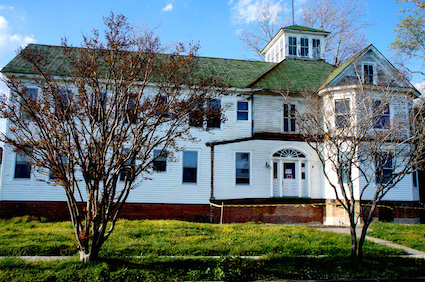
Front porch has been removed from old Northampton Hotel. (Wave photo)
By WAYNE CREED
Cape Charles Wave
April 27, 2015
The Cape Charles Harbor Area Review Board reviewed two high profile projects April 20 — the former Northampton Hotel at 1 Mason Avenue, and Patrick Hand’s Strawberry Street Corridor project. Both projects mean a lot to the rehabilitation and restoration of the Mason Street business district as well as to the overall historic character of Cape Charles itself.
Mr. Hand has applied for a review for new construction of a mixed-use development consisting of 20 one-bedroom residential units above commercial units on the cleared site of the old Meatland building. On April 14 the Board of Zoning Appeals approved four variances to the application after approving a demolition permit last December.
Harbor Area Review Board Chairman Ralph Orso questioned whether the applicant would be able to honor the variances following a VDOT site line inspection. It appeared the project could lose some parking spaces, dropping total parking to 38 or 39 spaces, while 40 spaces are required for the variance. Hand assured the Board that his engineer was working on the issue, and they were confident they would be able to achieve the 40 space total required. “Even with these slight changes, besides all the parking, we are still going to be able to keep the same amount of open and green space,” Hand said.
Board member Joan Natali wanted assurance that utility wires would be buried underground. Hand pointed out in the architectural drawings that not only would the utilities be underground, but that metering equipment would also be concealed inside a room. Natali also voiced concern regarding the roofline, which guidelines require to have a differentiation in height across the façade. Hand noted that due to the design, there was going to be a series of offsets from the façade that, from a “pedestrian perspective,” would provide a good bit of noticeable change in the roofline. [Read more…]
SHORE THING: Eastville Inn Fails Again
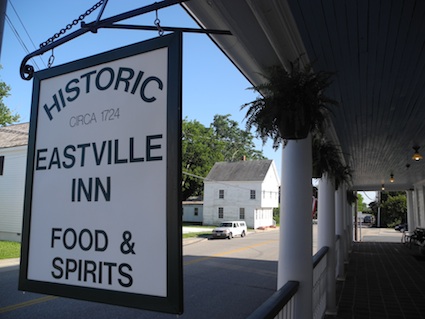
Eastville Inn’s bumpy ride in recent years reflects the difficulty of making a living from running a restaurant on the Eastern Shore.
By GEORGE SOUTHERN
Wave Columnist
April 27, 2015
A little shy of two years ago, Eastville resident and Wave student journalist Sarah Gollibart wrote an article entitled “Eastville Inn Rises Again.” It went on to become one of the Wave’s most-read stories of the year, so I know that a lot of folks are interested in the Eastville Inn.
But after the Inn shut down again on March 24, I started wondering, just what does it take to run a successful restaurant on the lower Eastern Shore? If the Eastville Inn can’t make it, who can – and how?
The Eastville Inn is a good case study because on paper at least it has so much going for it. Start with a historic building (c.1724) in a quaint town. Add proximity to the courthouse and county seat government center. Top it off with a talented chef/owner (Brent Schmidt) who bent over backward to make his venture special and inviting.
So what went wrong? The quick response might be that Chef Schmidt’s nouvelle cuisine wasn’t the local clientele’s cup of tea – either in taste (light), portion (small), or price (high).
But wait a minute – those were some of the same causes attributed to the Eastville Inn’s failure two iterations earlier. Following that shutdown, a local team converted the Inn’s format to kind of an upscale Exmore Diner. But that didn’t work either – the former clientele didn’t like it, and the hoped-for new customers stayed at Yuk’s.
So I’m thinking that the Eastville Inn’s woes are not of its own doing but rather reflective of the whole lower Shore. This is a tough market! Follow me up Route 13 and see what I mean. [Read more…]
Historic District Review Board Approves Projects, Considers Paint Colors and Satellite Dishes
By WAYNE CREED
Cape Charles Wave
April 27, 2015
In 1954, the Supreme Court case of Berman v. Parker set a precedent which allowed local governments to “tear down an old building to improve a neighborhood.” This landmark case oddly led the way for the modern preservation movement.
The case was heard during the beginnings of the urban renewal movement, which sought to rehabilitate blight in America’s cities. Essentially, the ruling implied that aesthetics was enough to finally enforce a historic district’s preservation efforts. That is, a historic district could endeavor to protect historic neighborhoods based on visual importance.
From the early attempts creating historic districts, such as Charleston, Savannah, or New Orleans, several key concepts have evolved, such as to protect significant historic properties against the threat of development, to encourage development in an older area, to maintain property values, or to create a brand or image of the place.
Of course, there is the economic effect. Don Rypkema, in The Economics of Rehabilitation, states that historic reinvestment can generate tax credits and can establish a new and higher depreciation schedule, extend the property’s economic life, and achieve a better quantity, quality, and durability of the income stream. Also, it can stimulate tourism, private, increased property values, property values and sales tax, create jobs and compatible land use patterns.
On April 21, town officials in charge of this preservation effort, the Historic District Review Board, met to revisit the Certificate of Appropriateness for each of two properties, 1 Mason Avenue (The Hotel), and 205 Jefferson Avenue. [Read more…]
LETTER: Chicken Houses Will Lower Property Values
April 27, 2015
EDITOR’S NOTE: Professor Art Schwarzschild submitted the following letter April 20 to the Northampton County Board of Supervisors, asking that it be made public record.
Dear Members of the Northampton County Board of Supervisors, Planning Commission, and County Staff,
I would like to start this letter with an apology for the tone of my last letter which questioned the motivations behind what I saw as the mysterious insertion of the new zoning use, “Event Venue,” into the revised draft zoning proposal. That being said, I believe it is important for you to understand that the back room procedure being used to write and repeatedly tweak the proposed zoning changes with little to no public involvement or explanation has led many Northampton County residents to question the motivations behind the proposed changes.
Once again, I would remind you of the comparison between the procedure used to create our current zoning code and this ongoing and confusing process. During the previous process the public was invited and encouraged to attend zoning work sessions in order to help craft a new comprehensive plan and zoning ordinance. These public work sessions were run by the County Planning Director and Planning Staff with additional support from paid consultants.
Members of the PC and BOS were in attendance at each of these meetings to witness public input. Scientific data, Economic Reports and Case Studies were presented and used as guides to ask citizens what they wanted to see in Northampton County and to help provide a realistic road map for us to achieve these outcomes.
In stark contrast, I have seen no data, surveys, or case studies used to support the multitude of zoning changes being proposed. What’s even worse, these changes have often been presented in a confusing and misleading manner. [Read more…]
LETTER: Lost Foreign Trade Zone Status Is Tragedy
April 27, 2015
DEAR EDITOR,
On October 23, 2012, you published my commentary, Expert Warns Eastern Shore: Special Trade Zone Status Slipping Away. Now it has happened.
As Virginia political leaders decide whether President Obama deserves fast approval powers for two massive trade agreements, the entire Eastern Shore has lost a valuable global trade incentive overlaying properties at Wallops Island (Site 14), Accomack Airport (Site 15), and in Cape Charles (Site 18).
I warned your community this might happen back in 2012. Your specially designated U.S. Foreign-Trade Zone sites are gone. However, the State of Virginia continues to promote to investors and traders an incentive that no longer exists. A Northampton County economic development staffer continues to mislead inquirers that it’s simple to regain designation. It’s not. Your congressional delegation and local elected officials repeat the same misleading information. [Read more…]


